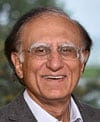
Thought Leadership
In a Crisis, Don’t Chase Shiny, Bright Objects
The standard reaction to a business crisis is well known: rally the troops, brainstorm solutions, identify new opportunities, and pursue them as quickly as possible. If you’re not moving, you perish. That’s the accepted wisdom.
Is it really so wise, though? Sanjay Khosla, Senior Fellow and Adjunct Professor of Marketing and co-Academic Director of Kellogg Executive Education’s Delivering Business Growth program, knows the answer is no. Moreover, he’s proven it when working with his consulting clients who have made that very mistake.
“A successful business was under pressure because of uncertainty and the COVID-19 lockdown,” he said. “We came in and saw their laundry list of ideas, ten of which came from the CEO. They were emailing everyone and saying, ‘Why don’t you try this? Why don’t you try that? Why don’t we get into masks?’ We told them to put out the fire rather than tend to the garden. They did, and now the business is thriving.”
The ideas the client was pursuing fall under the umbrella of “shiny, bright objects,” Khosla explained, and they were all distractions sending people and resources in random directions, creating chaos when chaos might do the most harm. After the problem was pointed out, executives agreed to focus on what they could actually control, which, in their case, was the digital aspect of their business. They redeployed people from other areas who were idle, thanks to the constraints of the lockdown, and concentrated their efforts on e-commerce. (They were fortunate in that their supply chain remained unaffected.) “They focused on what they were good at and what they could control. As a result, they’re quadrupling their profits.”
The concept to employ in such a situation is “one team, one dream, one plan,” Khosla noted. Instead of fracturing your attention to indulge in activity for activity’s sake, you align and concentrate. The difference shows up in Zoom workshops he runs when one company is united in its focus and the other isn’t. “Company one is high-energy. They’re building off each other. There’s trust. In another company, they’re being murdered by PowerPoints, half the people are multitasking, some people have got their video switched off, and they’re clearly not engaged. That’s the kind of contrast I’m seeing so much of.”
One element of eliminating the distraction of shiny, bright objects is identifying the source. All too often, it comes from the top, as was the case with Khosla’s most recent client success. “I’ve been coaching the CEO, and I’ve had to tell her to stop sending emails and ideas,” Khosla said. “She keeps sending emails to various parts of the organization. That was always her habit. Her ideas were distracting everyone because the boss sent them. The solution is, mute the boss. She needs to make the final decision, but otherwise let go. She’s only involved if there is conflict and choices to be made or investment beyond a certain level that would require her involvement.”
How does one determine whether an idea is a shiny, bright object? Employ two methods of evaluating it. The first is the lens of the “three Ms,” which are margin, momentum and materiality. “If it’s got no margin potential, don’t do it,” Khosla said. “If momentum—growth potential—doesn’t exist, don’t do it. If the materiality—the sales potential—isn’t there, don’t do it.
The second is to focus on things by time: short-term, medium-term, long-term. “Often, many of the ideas are long-term,” Khosla said. “But if your house is burning, you better have the short term and medium term covered, too.”
Those two mechanisms are the specific ways to focus on what really matters, he added. “And that’s where you win.”
 |
Sanjay Khosla is a Senior Fellow at Northwestern University's Kellogg School of Management and a Senior Advisor at Boston Consulting Group. He teaches in a variety of Kellogg Executive Education programs, including Delivering Business Growth and Kellogg on Branding. He is the co-author of Fewer, Bigger, Bolder with his colleague Mohan Sawhney. |
Delivering Business Growth
Emphasizing action, this program teaches a market-tested framework that has delivered sustained double-digit growth in revenues and margins for major global brands. You’ll leave with a business growth strategy and actionable agenda for driving growth within your organization.
Upcoming Sessions
|
June 15-18, 2026 Start: June 15 at 1:00 PM End: June 18 at 11:45 AM
A preferred hotel rate is available at the Omni Chicago. |
$9,950 Fee does not include accommodations. |
|
|
October 26-29, 2026 Start: October 26 at 1:00 PM End: October 29 at 11:45 AM
A preferred hotel rate is available at the Hyatt Coral Gables (use code 60167). |
$9,950 Fee does not include accommodations. |



